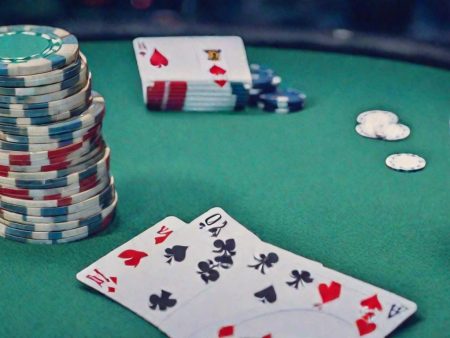The strategy a player employs during a specific poker hand depends on several key factors within an online casino environment, including their pocket cards, position at the table, and the strength of their opponents. One of the most crucial elements that influence a player’s decisions is the number of chips they have at their disposal. When you possess a substantial number of chips, you’re in a better position to play hands creatively, even with weaker cards. However, with fewer chips, you typically have two choices: either fold or go all-in.
What is a Stack in Poker and What Does It Represent?
A stack refers to the number of chips a player holds during a game. In cash games, the stack size is directly tied to the amount of money you have at the table. For example, if you have $5,000 in chips, you can exchange them for cash at the casino cashier. In tournaments, however, things are a bit more complex: players start with an equal number of chips for a fixed buy-in and continue to play until they either win or are eliminated.
It’s important to note that a player’s stack can be measured not only in monetary value but also in big blinds. The larger your stack, the more comfortable and flexible you are in making moves. This becomes even more significant when your opponents are playing with smaller stacks, as you can apply pressure on them by raising frequently. When reviewing a live dealer casino, it’s important to understand not only player reviews but also the terminology involved to ensure clarity.
Read also: What is a showdown in poker and who is the first to open.
Different Types of Stacks and Their Characteristics
Let’s explore the different types of stacks based on their size:
- Deep Stack: Common in cash games and the early stages of tournaments, a deep stack consists of 80 or more big blinds. This allows players to be more flexible, playing a wider range of hands. A stack of around 200 big blinds provides an even more comfortable cushion, giving players more room to maneuver. Beginners are often advised to participate in tournaments with a slower structure to better grasp the fundamentals of tournament poker.
- Average Stack: Typically ranging from 30 to 60 big blinds, average stacks are quite common in tournament settings, especially during the bubble stage, as players approach the prize zone. While they offer some comfort, a single poor hand could be enough to eliminate a player from the game.
- Short Stack: When a player has 20 big blinds or fewer, this is considered a short stack. At this point, players usually have no option but to either go all-in or fold. It’s a tricky yet simple phase of the game — difficult due to the high-risk nature of all-in decisions, but easy because the decision boils down to just two choices.
- Ultra-Short Stack: This refers to having just 10 big blinds or less, which makes for one of the most precarious situations in poker. Players with an ultra-short stack must adopt an aggressive strategy, typically focusing on preflop decisions. A popular approach in such cases is the ‘Sklansky-Chubukov push’, named after poker theorist David Sklansky and math professor Andrei Chubukov, which focuses on push strategies with minimal chips.
- Incomplete Stack: This refers to a stack between 30 and 70 big blinds, requiring more caution than a deep stack but offering enough flexibility to stay in the game. With a short stack of around 25 big blinds, players must carefully choose when to act and when to fold.
How to Play with Different Stacks in Tournaments vs. Cash Games
In cash games, players typically prefer to maintain a full stack of 100 big blinds, providing the freedom to buy more chips should they face a loss. In contrast, tournament players must rely solely on the chips they start with and must strategically plan their moves based on their stack size throughout the event. It’s crucial to choose tournaments with an appropriate structure, as this provides ample time to make well-thought-out decisions and better understand the nuances of tournament poker.
How to Calculate Your Stack
Understanding your stack is vital for determining the optimal size of your bets. The simplest approach is to calculate how many big blinds your total chip count equates to. To do this, divide the total number of chips you have by the current big blind value. For example, if you have 3,500 chips and the blinds are set at 50/100, you would divide 3,500 by 100, giving you a stack of 35 big blinds.
During major poker tournaments, the blinds — and by extension, the stack sizes — increase as the game progresses. Early in the tournament, players may have stacks of 100 or even 200 big blinds, but as the event moves towards its final stages, a stack of 30 big blinds may still be considered a valuable asset.
Read also: What is a rebuy in poker.
Real Stack and Efficiency in Poker
The term “real stack” is crucial when evaluating your chip stack in relation to others. If you’re involved in an all-in situation and have more chips than your opponents, you won’t be able to double your stack by winning the pot. Instead, you’ll win the total pot plus the chips of any opponent who calls, but you won’t receive more than what you’ve put in. This is where “efficiency” comes into play — it refers to the smallest number of chips that can be used effectively during a hand. For instance, if one player has 50 big blinds and another only 7, the effective stack size for both players in that hand would be 7 big blinds, as that’s the maximum the player with the larger stack can lose in that particular hand.
Final Thoughts
Your poker stack is an essential part of shaping your strategy, determining your approach to the game, and managing your risks. Understanding the different stack sizes and knowing how to adjust your play accordingly is key to long-term success. Whether you’re playing in a cash game or tournament, adapting to your stack size and leveraging the appropriate strategies will help you make smarter decisions and increase your chances of winning. If you’re looking for casinos with deposits starting at $10 or more, check out our recommended platforms. And for more insights into the gambling world, don’t forget to visit our blog. Want to learn more about gambling? Read the casino blog – expert tips, strategies, and game reviews are waiting for you!
FAQ: What is a stack in poker: types, strategies and techniques
What is a stack in poker?
A stack in poker refers to the total amount of chips a player has available to bet during a hand. It is essentially the pile of chips in front of a player, which they can use to place bets or raises throughout the game. The size of a player's stack can have a significant impact on their strategy and decisions during the hand.
What are the different types of stacks in poker?
There are several types of stacks in poker, often categorized by their size relative to the blinds and the pot:
- Deep Stack: A deep stack refers to having a large number of chips compared to the blinds. Players with deep stacks can make more strategic plays, as they have more chips to absorb losses and can afford to take bigger risks.
- Short Stack: A short stack is when a player has fewer chips compared to the blinds. Short stack players are often more conservative, as they have less room to maneuver and must choose their spots carefully.
- Medium Stack: This is the middle ground, where a player has a moderate number of chips. Players with a medium stack need to balance aggression and caution, depending on the dynamics of the table.
How does the size of my stack affect my poker strategy?
The size of your stack plays a key role in determining your strategy. If you have a deep stack, you can afford to play more aggressively, potentially trapping opponents with strong hands or bluffing. With a short stack, you'll need to be more selective and make fewer mistakes, as you're at a greater risk of being eliminated from the hand. A medium stack gives you flexibility, but you still need to adjust based on the flow of the game.
What is a “stack-to-pot ratio” (SPR) in poker?
The stack-to-pot ratio (SPR) is a concept used to assess the relationship between the size of the stack and the size of the pot in a hand. It helps players decide how much to commit to a hand based on their stack size. A low SPR (when the pot is large relative to the stack) means you're more likely to get all-in with a strong hand, while a high SPR suggests you can make more nuanced decisions and control the pot size.
What is the best strategy for deep stack poker?
In deep stack poker, players can afford to take more time and evaluate each decision more carefully. Aggression, positioning, and post-flop play become more important, as you have enough chips to maneuver through several betting rounds. The key is to build the pot when you have a strong hand and manage your chips wisely when you're facing tough decisions.
What strategies should I use when I have a short stack in poker?
With a short stack, the strategy is generally more focused on survival and making the most out of every hand. You may need to be more selective with the hands you play, focusing on hands with strong potential. Push or fold strategies become more important, as you need to be prepared to go all-in with a strong hand or when you're in a good spot to steal the blinds.
How can I manage my stack size in poker?
Managing your stack size involves being aware of your position in the game and adjusting your strategy accordingly. It's essential to protect your stack by avoiding unnecessary risks when you're short-stacked and using your deep stack to apply pressure on opponents when you're in a favorable position. Monitoring your stack and adjusting to the dynamics of the game can greatly influence your overall success at the table.






